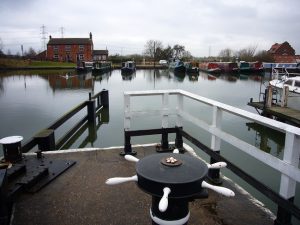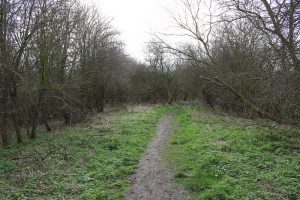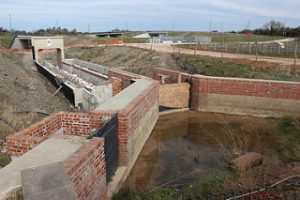The West Stockwith basin at the River Trent end of the canal.
John attended Sheffield University and became a chartered civil engineer. In 1981 he became involved with the Chesterfield Canal Trust, a registered charity with many volunteers.
The Past: The canal was built in 1777. James Brindley being the engineer. It was a magnificent achievement for its time including the 2,880 yard Norwood Tunnel. The prime purpose of the canal was to carry Derbyshire coal to new markets on canal barges. It was a big saving on previous methods whereby ten pack-horses were needed to transport one ton of coal. A barge could hold 24 tons of coal.
Due to the coming of the railways boat traffic declined and in 1907 the collapse of part of the Norwood Tunnel isolated the Derbyshire section of the canal.
In 1834 there was a big fire in the Houses of Parliament and stone which was quarried at North Anston was taken by barges to West Stockwith and then to London via the Trent, Humber, North Sea and the Thames.
The Present: In the 1950’s the 26 miles between West Stockwith and Worksop were barely navigable. A campaign was started by the Retford and Worksop Boat Club to save the canal. Funding was granted and this section of the canal was restored.
John showed us many pictures depicting the canal restoration . Grassy fields with a slightly sunken path indicating the previous route of the canal became restored canals due to the efforts of the volunteers.
The path is the centre line of the canal.
The brickwork and masonry skills of the volunteers were second to none and would have put many of today’s builders to shame. So many projects of restored canal sections, locks, and towpaths, were shown to us and the before and after shots were amazing.
In 1978 The Telegraph reported that an over keen worker, clearing rubbish from the canal, caught his hook on a chain. He pulled hard and out came “the plug” resulting in all the water being drained from that section of the canal. Nowadays it is no longer possible to drain the canal because of environmental reasons i.e. the potential loss of fish and wildlife etc.
At Staveley, an archaeological dig was commenced by students. This resulted in unearthing three old original cuckoo boats. These were the original type of barges made for the canal. The find of the cuckoo boats prompted the volunteers to build a replica cuckoo boat by hand using all the old skills of the workers. A “steam box” was used to bend the planks which formed the bow of the boat and similar materials and skills were employed. The boat was launched in 2015, recreated with copies of the original mast and sails and named “The Dawn Rose”.
Millions of pounds have been needed to restore sections of the canal, many with Government grants plus a sizeable sum from fundraising and public donations. Sponsored “boat pulls” and other events have contributed to the restoration funds.
The Future: The future plans for the HS2 railway also impact on the canal. Many consultations have resulted in part of the HS2 track being rerouted from the present canal route into a housing estate in Mexborough.
The latest construction is a £310 million Chesterfield waterside complex. This is still underway. The long term aim is to link up sections of different canals in three adjacent counties to rival the navigable waterways of the Midlands and the North West.
2027 will be the 250th anniversary of the Chesterfield Canal and it is hoped that all work will be completed by then.
There are many delightful walks along the canal, boat trips and activities organised by the Chesterfield Canal Trust.
Have a day out on the canal and enjoy all that it has to offer!
John’s talk was very well received and he was thanked for his interesting and beautifully illustrated presentation – many of which can be seen, along with a host of information, on their website – http://www.chesterfield-canal-trust.org.uk/
A map of the canal can be found here: http://www.chesterfield-canal-trust.org.uk/on-the-water/canal-maps/#more-7054



